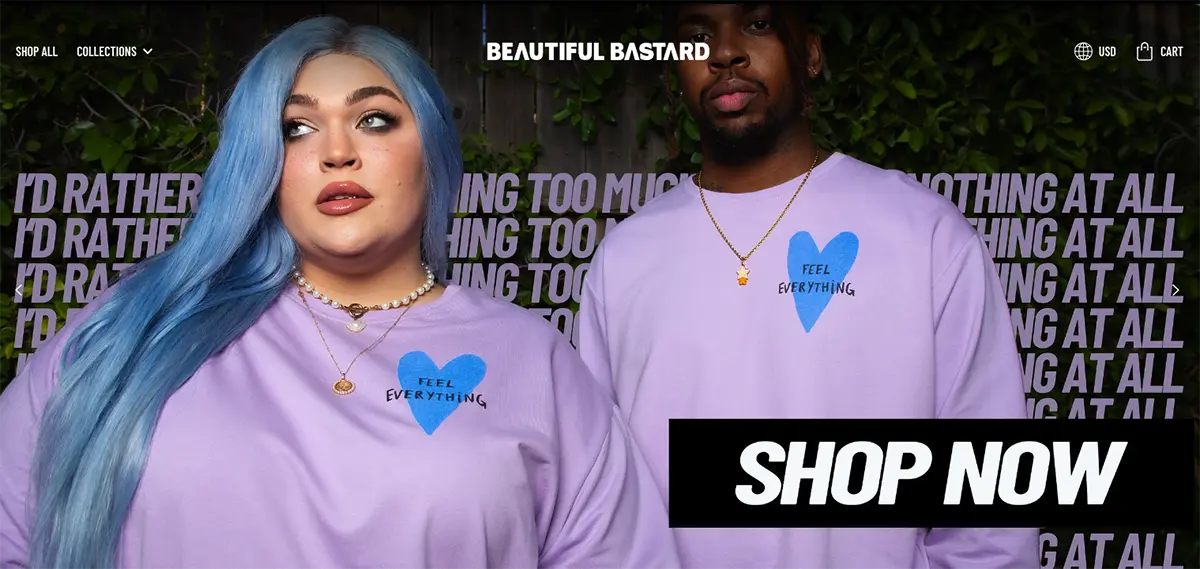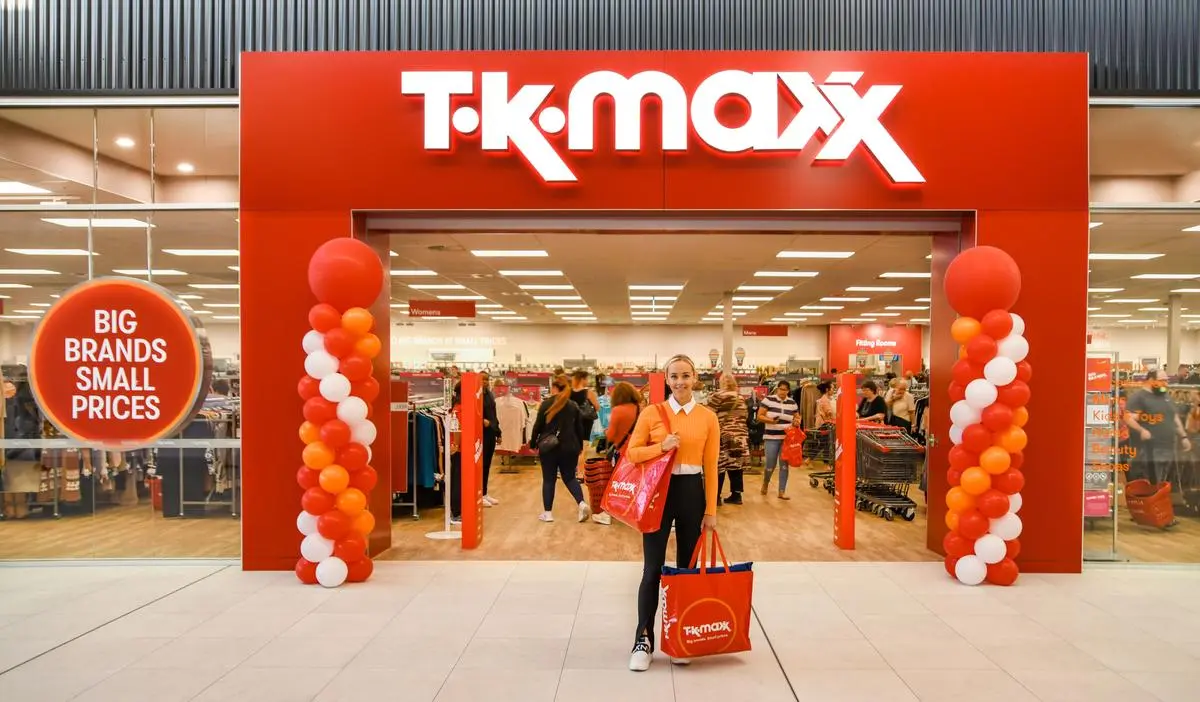30 Creative Names for a Clothing Brand: Top Brand Name Ideas

For content creators stepping into the apparel industry, choosing the right clothing brand name is pivotal to establishing a strong presence in fashion. A memorable name not only distinguishes your brand but also communicates its unique style to potential customers.
A well-chosen name can evoke the essence of your brand, setting the tone for your entire business. Take creators like Philip DeFranco and Aimee Song, for example.
DeFranco's Beautiful Bastard captures a bold, edgy vibe that aligns with his straightforward and charismatic persona, attracting a loyal following that appreciates his unique blend of style and attitude.
In contrast, Amiya reflects Aimee Song’s sophisticated yet approachable aesthetic, appealing to her audience who values elegance and modernity in fashion. These names do more than just label a product; they tell a story, evoke emotions, and create a strong connection with the audience.
In this article, we'll inspire your creativity with a diverse array of clothing business names, store monikers, line ideas, and company names to help you craft a standout brand that speaks to your audience.

How to Choose a Clothing Brand Name
1. Get to Know Your Brand
Before choosing a name, it's crucial to understand your brand's story, mission, and values. Your fashion brand’s name should reflect what your company stands for and what it represents.
Start by asking yourself key questions: What is the core mission of your brand? What values do you want to communicate to your customers? What story does your brand tell, and what emotions do you want it to evoke? Consider your target audience and the unique qualities that set your brand apart from competitors.
By gaining a deep understanding of these elements, you can select a name that encapsulates your brand's identity, resonates with your audience, and provides a solid foundation for your marketing efforts and overall business strategy. This introspective process ensures that your brand name is not just a label but a meaningful representation of your brand's essence and vision.
2. Consider Your Target Audience
Who do you want to attract with your clothing brand? Understanding your target audience is essential as it influences the style, tone, and language of your brand name. By thoroughly researching and defining your target demographic, you can tailor your clothing line to meet their specific needs and preferences.
For instance, if your audience is young and trendy, a name that is playful and edgy might resonate well with them. Conversely, if your audience values sophistication and luxury, a name that exudes elegance and refinement will be more appealing. Furthermore, knowing your audience allows you to highlight aspects of your brand that they love, whether it’s sustainability, quality, or innovative designs.
By aligning your brand name with the values and desires of your target customers, you create a stronger connection with them, making your brand more relatable and attractive, ultimately driving customer loyalty and business success.
3. Analyze Your Competitors
Researching your competitors' names, styles, and marketing strategies is a critical step in creating a unique fashion brand that stands out in the market. By studying competitors, you gain insights into what works well and what doesn't within your niche.
Look at how their names reflect their brand identities, the language they use, and the emotional responses they evoke from their audience. This analysis can reveal gaps in the market and opportunities for differentiation. For instance, if many competitors use names that convey minimalism, you might choose a name that exudes vibrancy and creativity to capture a different segment of the market.
Additionally, understanding how competitors market their brands can inspire innovative approaches for your own brand's positioning and messaging. By leveraging this knowledge, you can craft a distinctive name that not only avoids overlap with existing brands but also clearly communicates your unique value proposition, setting the stage for your brand to attract attention and thrive in a competitive landscape.
4. Seek Feedback
Don't make the mistake of choosing a name in isolation; seeking feedback is an invaluable part of the naming process. By gathering opinions from friends, family, or even directly from your target audience, you can gain diverse perspectives and insights that you might not have considered.
This type of feedback helps ensure that your brand name resonates well and avoids any unintended negative connotations or misunderstandings. Additionally, receiving input from others through focus groups, surveys, and social media pools can provide you with a reality check on how your brand name is perceived and whether it effectively communicates the essence of your brand. This collaborative approach not only validates your choice but also strengthens your connection with your audience by showing that you value their opinions.
5. Check for Availability
Before finalizing your brand name, it's essential to verify its availability as a domain name and on social media platforms. This step ensures that your brand remains consistent across all digital channels, which is crucial for establishing a strong and cohesive online presence.
Start by conducting a domain search to see if your desired name or a close variation is available. A matching domain name not only makes it easier for customers to find you online but also adds to your brand's credibility.
Next, check the availability of the name on major social media platforms such as Instagram, Facebook, Twitter, and TikTok. Securing consistent handles across these platforms helps maintain brand uniformity and prevents customer confusion.
Moreover, securing an available domain name can help you avoid potential legal issues related to trademark infringement. Ensuring your brand name is available across all these channels provides a solid foundation for your digital marketing strategy, enhancing your brand’s visibility and making it easier for customers to connect with you across multiple touchpoints.
30 Clothing Business Name Ideas to Inspire You
Finding inspiration for your clothing brand name can be challenging. Here are some ideas grouped into different categories to spark your creativity:
Unique Clothing Brand Names:
1. Blush Threads
2. Indigo Cottage
3. Wildflower Apparel
4. The Finery Co.
5. Ember & Ivy
Catchy Clothing Brand Names:
1. Bright Attire
2. Bold & Cozy
3. Daring Apparel
4. Pizzazz Wear
5. Sparkle Style
Cool Clothing Brand Names:
1. Blue Beat Clothing
2. Thunder Threads
3. Arctic Attire
4. Vibe Wear
5. Urban Edge Clothing
Funny Clothing Brand Names:
1. Duck Me Up
2. Mon-stache
3. Waterlemon
4. Pineapple Party
5. Donut Worry Clothing
Cute Clothing Brand Names:
1. Bow & Arrows Apparel
2. Little Bubble Co.
3. Peppy Wear
4. Flamingo Fashions
5. Reindeer Attire
Hoodie Clothing Brand Name Ideas:
1. Hoodie Heaven Co.
2. Cozy Kingdom
3. Snuggle Threads
4. Hoodie Hut
5. Comfy Co.
5 Tips for Choosing a Good Clothing Brand Name
1. Keep It Simple and Memorable
Your brand name should be easy to spell, pronounce, and remember, as these factors play a crucial role in shaping customer perception and brand recognition. Brands like Nike, Apple, and Zara exemplify the power of simplicity in naming. Their short, straightforward names are not only globally recognized but also easy for consumers to recall, facilitating brand awareness and loyalty.
Research supports the impact of simplicity in brand names on consumer behavior. Studies have found that names that are easier to pronounce can influence impression formation and decision-making. This is particularly relevant in the fashion industry, where the brand name often serves as the first point of contact with potential customers. These names reduce cognitive load, making it easier for customers to recall and talk about your brand, thereby enhancing word-of-mouth marketing.

2. Think Globally
Consider the possibility of expanding your brand overseas. Ensure your chosen name resonates not only in your local market but also in other languages and cultures. A name that works well in one language might have unintended meanings or even similarities to another brand in other countries.
For example, T.J. Maxx had to rebrand their name overseas in the U.K. to avoid confusion with the already established and popular retail chain T.J. Hughes. The apparel store is known as T.K. Maxx in the U.K., illustrating how crucial it is to adapt your brand name for different markets.
By conducting thorough research and cultural checks, you can ensure your brand name is universally appealing and avoids potential legal and cultural issues. This proactive approach can facilitate smoother international expansion, enhance brand consistency, and ensure your brand name effectively communicates your identity across various regions.

3. Use AI as Inspiration
Using online brand name generators like Canva’s Magic Write can be invaluable for generating unique and creative names for your brand. These tools employ advanced algorithms to analyze patterns, trends, and linguistic structures, offering suggestions that are both innovative and memorable.
By inputting keywords related to your business, Magic Write generates names across categories such as common, new, short, fun, and SEO-friendly, providing a diverse array of options tailored to your brand's identity and market positioning.
This approach not only saves time but also expands your naming possibilities beyond traditional brainstorming methods. AI-driven name generation ensures that the names you consider are optimized for digital visibility, enhancing your brand's ability to stand out in a competitive marketplace.
When using AI for inspiration, you can discover names that resonate with your target audience while aligning with current trends, setting a strong foundation for brand recognition and online presence.

4. Test for Uniqueness
Before finalizing your brand name, conducting a thorough trademark search is essential to ensure its uniqueness and mitigate potential legal risks. This step is crucial for protecting your brand from infringement disputes and establishing a robust, defensible identity in the marketplace.
Utilizing tools like the United States Patent and Trademark Office (USPTO) database or WIPO’s Global Brand Database allows you to check the availability of your chosen name and identify any existing trademarks that may conflict with yours.
According to the International Trademark Association (INTA), trademark conflicts can lead to costly legal battles and necessitate disruptive rebranding efforts, which can be particularly detrimental for startups and small businesses.
Verifying the uniqueness of your clothing brand’s name early on safeguards your investment in branding and marketing efforts, avoiding potential setbacks and safeguarding your reputation.
5. Make It Scalable
Your brand name should be flexible enough to expand your product range or change your business model without losing its original meaning.
A scalable name allows your brand to expand its product range or adapt its business model over time while maintaining brand coherence and recognition. Amazon provides a prime example: starting as an online bookstore, its name did not confine it to a single category, enabling it to diversify into various industries and become a global e-commerce leader
McKinsey & Company's research underscores that businesses capable of pivoting and expanding their offerings tend to achieve greater success. A scalable name supports these strategic shifts by remaining adaptable and resonant across different markets and product lines.
This kind of flexibility not only future-proofs your brand against market fluctuations but also fosters customer loyalty and brand equity by maintaining a consistent brand essence amidst growth and change.

Frequently Asked Questions
1. What makes a clothing brand name effective?
An effective clothing brand name should capture the essence of your brand, conveying its core values and style to resonate with your target audience. It should be simple and memorable, ensuring that customers can easily recall and share it. Additionally, originality is key, as a unique name helps distinguish your brand from competitors, fostering a strong and distinct identity in the marketplace.
2. What is a perfect name for a business?
A perfect business name reflects the core values and identity of your brand, resonating deeply with your target audience by conveying the right message and tone. It should be easy to remember, ensuring that it sticks in the minds of customers and is easily shareable. Moreover, the name must be unique, distinguishing your business from competitors and avoiding any potential legal issues related to trademark conflicts.
3. Can I change my clothing business name later if necessary?
Yes, you can change your business name later if necessary, but it can be both expensive and time-consuming, involving rebranding efforts such as updating marketing materials, legal documents, and online presence.
This process can also confuse existing customers and potentially disrupt brand recognition and loyalty. Therefore, it's better to select a name that you are confident with from the start, ensuring it aligns with your long-term vision and goals to avoid the complexities and costs of a name change down the road.
Level Up Your Clothing Brand With Fourthwall
Growing your clothing brand can be challenging, but with Fourthwall, creators can easily customize and sell their own clothing online.
This all-in-one ecommerce platform simplifies the process by providing intuitive tools to create engaging homepages, shops, and membership options that resonate with your community. Creators can focus on their creativity and brand identity while Fourthwall manages the logistics, including production, shipping, and customer service.
Additionally, Fourthwall offers the ability to create your own custom domain name for free, ensuring that your brand maintains a professional and cohesive online presence. With a custom domain, your brand’s website becomes more memorable and accessible, enhancing its credibility and visibility.
Sign up with Fourthwall today and discover how you can elevate your clothing brand and connect more effectively with your audience.
















